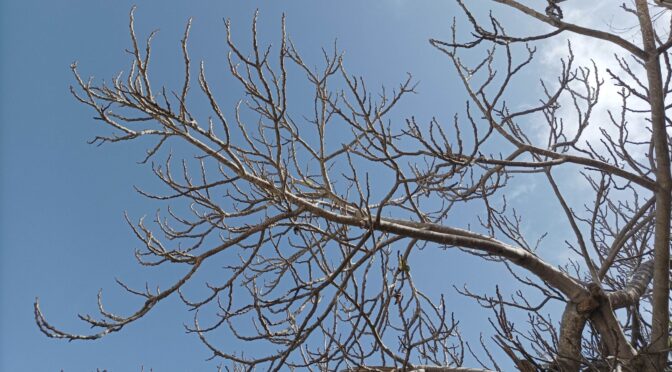Views: 1049
The fig tree begins its winter retreat. For a few months, it will enter a period of seclusion, isolating itself from its surroundings. It absorbs the most vital essences from its large leaves, then lets them fall, creating a meaningful layer of dry, dead matter.
This sudden change in the landscape reveals bare branches against the horizon, a characteristic feature of some parts of Menorca. But these fallen leaves, which now blanket the ground, will not be a troublesome waste. A concentration of small animals will devour and transform them into soluble organic matter, nourishing the roots.
Nearby, the lentisk shows its generosity. All summer long, it remains green, contrasting with the ochre of cultivated fields. Towards the end of the dry season, when everything seems exhausted from lack of water, it produces new shoots, an even fresher, more vibrant green.
After the rains, it’s filled with red berries that will soon ripen, becoming thousands of tiny meals for birds. These wild fruits use the birds’ ability to fly as a means of dispersal, hitching a ride in their bellies and being dropped elsewhere along with a useful package of organic fertilizer. The leaves it renews also create a rich substrate, highly valued in gardening.
The softening of the soil signals some ant species to spread their colonies. New queens emerge equipped with wings, enjoying a brief privilege of flight. For a few hours, they will see the world from above, joined by males from neighboring colonies.
Once the queen has mated with as many males as possible, she returns to the ground and makes a drastic life change. She removes her wings and digs into the soft earth to create a nest, never to emerge again. The sperm collected during her nuptial flight will allow her to lay eggs for many years. She will nourish the first workers with her own reserves until there are enough to go out and gather food. This is how a new colony is born.
The males will die after mating, only to be eaten by others. If they fall near their own colony, the workers who raised them will break them into pieces, providing protein for their underground society. In nature, the cycle of matter is complete.
These are things that happen in autumn and can be easily observed if you have a bit of curiosity. More people should do so, especially those who haven’t yet understood the problem humans create when we don’t close the loop on the waste we generate.
Now, there are organized tours to observe the waste management at the Milà landfill, where all of Menorca’s waste ends up. It’s a highly recommended experience to understand the urgent need for societal change regarding the waste each of us produces.
This is an initiative that needs to be promoted to combat the uninformed opinions surrounding door-to-door waste collection systems. Everyone needs to collaborate to lift society out of the environmental adolescence in which some people remain.
The falling fig leaves remind us of the passage of time and life’s changes, offering inspiration to better recycle the waste we produce.
(This text is an adaptation of the original article published by Miquel Camps, as coordinator of territorial policy for the GOB, in the Menorca newspaper on 14/10/2024).

